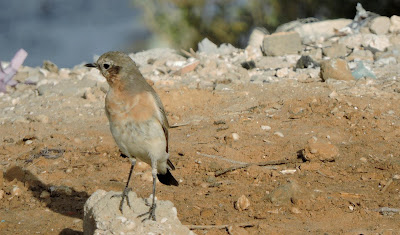Through all the rubbish, it is real gem. It has small clumps of dense reed beds and vast amounts of water. Some of which is contaminated, some looks nearly pristine.
I visited the lake again on Wednesday afternoon after work. I checked the gulls for rarities. Once again with no success. I scanned the water for any new water birds. I spent a lot of time inspecting the reeds for passerines but only came up with (lots of) chiffchaff this time.
I deliberately stayed late to look for crakes. I selected two spots which had the most potential. I could not believe my eyes when I turned up at the second spot to see a Baillon's crake walk on to the scene.
a Baillon's crake arrives
The water in this spot has a covering of vegetation but only a small clump of reeds. I presummed the thin covering would hold a crake's weight and I was right.
Baillon's crake in the reeds
Given the small size of the reedbed, the crake spent much of its time in the open on the top surface of the water.
crake back on the water
Identifcation was a little tricky since it was showing a large number of primary tips. This is usually associated with a little crake. However the plumage including the lack of a red base to the bill and streaked top of the breast as well as number of spots on the mantle fitted Baillon's crake. The reason for the large number of primary tips was because the tertials had become folded. The identification was tested and confirmed on BirdForum.
Baillon's crake from the rear
Baillon's crake is much rarer in western Europe than eastern Europe and Asia so the number of wintering birds is less. It's not yet on the e-bird list for the country.
Baillon's crake as dusk approaches
BirdLife International, The Birds of Western Africa and the Mauritanian Bird Atlas show it wintering in the Senegal River delta. Indeed that area appears to be the primary wintering place for birds throughout western Europe. The Mauritanian Bird Atlas suggests that there is strong breeding evidence there too. Elsewhere it is unexpected and certainly not in Noaukchott in mid winter.
African swamphen at dusk
As I headed for home, I glimpsed an African swamphen in the last embers of light.
I have made a note to investigate the site for nightjars at night though I need to get equipment and security sorted.
northern wheatear 1
Earlier, as I have said, I concentrated a lot on passerines. As well as chiffchaff in the reeds, Sudanese golden sparrow were present again and a second northern wheatear was seen for the first time.
northern wheatear 2
There is still time this winter for the cold weather further north to push new passerines down or even ducks for that matter. Then spring may bring both returning Euoprean and intra-African migrants. The lake still holds prospects.









No comments:
Post a Comment